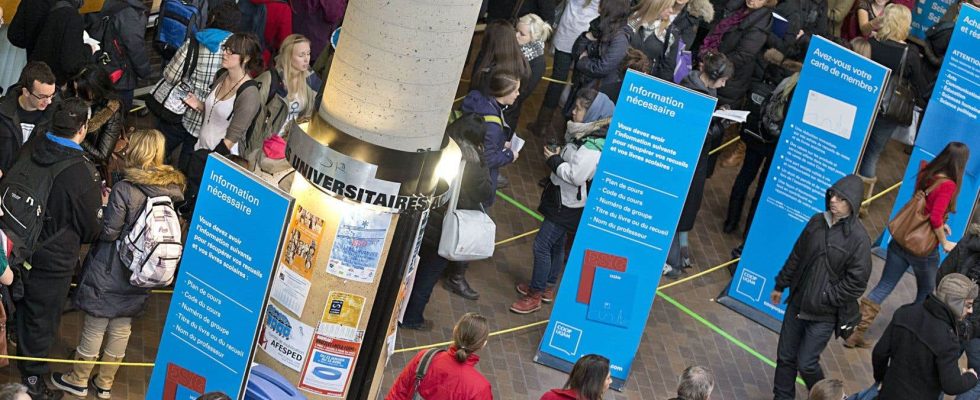That’s nearly half a billion dollars in student financial assistance (AFE) that was not used over a period of six years in Quebec, noted The duty. Outdated admission criteria in a context of rising costs of living and minimum wages are said to be at issue, a situation denounced by several student associations.
Questioned Tuesday by solidarity MP Sol Zanetti, the Minister of Higher Education, Pascale Déry, was unable to say what amount of money invested by Quebec in the AFE returns annually to the government coffers. “We have noticed a drop in requests from beneficiaries in recent years. We are very concerned about that,” said M.me Déry, as part of the study of the budgetary appropriations of his ministry.
An analysis of the Duty based on data provided by the Ministry of Higher Education and taken from its annual reports shows that nearly 10% of the 4.94 billion that were invested in the AFE between the 2017-2018 and 2022-2023 school years n have not been requested by students. That’s $483.22 million. Conversely, during the 2016-2017 school year, the government spent $20.37 million in excess to provide loans and bursaries to students in the province.
“It’s money that the government says it gives to students and that it doesn’t give to students,” while the latter need it “more than ever,” lamented Sol Zanetti in an interview. “Right now, students are going to food banks, […] in shelters for homeless people, they are floundering with the housing crisis, they are in economic and financial distress”, but they do not have full access to the AFE, which leads them to go into debt, launched the ‘elected. “It doesn’t look good!” »
A “decrease in demands”
The ministry’s annual reports have reported for several years a constant decline in the number of people using the AFE. A percentage which notably fell by 9.1% for the 2021-2022 school year only, according to a government document which reports a trend that began five years earlier.
“The differences between expenditures for financial assistance programs for studies and the allocated budget can be explained, in particular, by the drop in requests made by students under the Loans and Bursaries Program as well as by the increase of students’ income, which has an impact on the assistance offered to them,” the Ministry of Higher Education explained by email on Wednesday.
However, for years, the Advisory Committee on Financial Accessibility to Studies has been asking that the parameters determining the monthly income beyond which students see the loans and scholarships to which they are entitled decrease be indexed at the same rate as salary growth. minimum. Because, even if Quebec has continued to invest more money in this program in recent years, the maximum income protected by the AFE remains several hundred dollars lower than what a student can earn by working full time at minimum wage.
The result is that there are “too many students who do not have access to” the AFE, which ensures that “the money remains on the table”, unused, Mr. Zanetti raised.
“The other way of thinking about it is to say: because there are significant needs in the job market, there are students who decide not to go to CEGEP or university. and they will work full time instead,” notes Pier-André Bouchard St-Amant, associate professor at the National School of Public Administration. Part of the AFE’s “surplus” can therefore be associated with the drop in full-time “student numbers” noted in the Quebec college and university networks in recent years, according to this expert.
Parameters to review
Several student associations joined by The duty thus believe that the parameters of the AFE are disconnected from reality, at a time when inflation has inflated the price of the grocery basket, rents and travel costs, among others. In this context, working while studying has become necessary for students who could not make ends meet by being satisfied with the living expenses of a maximum of $1,283 per month offered by the AFE to those who do not reside in the family house.
“We don’t want financial aid for studies to be a barrier to success,” said the president of the Fédération scolaire universitaire du Québec (FECQ), Laurence Mallette-Léonard. The latter affirms that students sometimes abandon their studies because the AFE does not meet their financial needs, or even decide to carry out their studies part-time in order to be able to work full-time during their school career.
Thousands of students not eligible for the AFE have also turned, in recent years, to private financial institutions to take out loans intended to finance their studies, showed last year a report prepared by the Research Group in applied public economics on behalf of the Quebec Student Union (UEQ). “It has neither head nor tail,” says Sol Zanetti. “They will drag these debts around for decades,” said the elected official, who is calling for a review of the AFE’s “criteria.”
A request also made by the president of the UEQ, Catherine Bibeau-Lorrain, who also believes that this program deserves to be “better communicated” to students. “Money is put on the table for people in the student financial aid program, but we need a place of intervention so that we can discuss the best ways to modify the parameters of the program so that they are better adapted to the reality of students,” she argues.
The government also took steps last year to reform its loan and scholarship program. A few meetings were then organized with the UEQ and the FECQ, according to our information, but these steps have made little progress since then, notes Mme Briefcase-Leonard. “We consider that this project was aborted. »
